Jim Russell Racing School: the best $1200 I ever spent
One of a series of posts about the racing antics we got up to before arriving in competitive karting. Check the overview for links to other posts in the series.
THIS is what I’d been waiting for.
I’d played with model cars, crewed for a Canadian championship race car, driven my road car in slaloms and ice-autocrosses, and finally I was going to get a shot at the real thing.
It was, without a doubt, the best $1,200 I’d ever spent.
This 19-year-old wanna-be racing driver was going to enjoy two-and-a-half days in the seat of a Jim Russell Racing School Formula Ford racing car speeding around the Grand Prix track at Mt. Tremblant, just north of Montreal.
It was where I’d watched my boyhood hero, Jackie Stewart, debut his new Tyrrell Formula 1 car in the 1970 Canadian Grand Prix and, the following year, burst the CanAm McLaren team’s bubble in his L&M Lola.
Now it was my turn — I was getting to drive on the same track in a Lotus 51A single-seater racing car. I wasn’t even driving it yet and I was still happier than a pig in… um… slop.
The Jim Russell Racing School was a world-famous place to get your feet wet in a single-seater formula car and was where many well-known drivers got training. Originally a British operation, it had expanded internationally. The Canadian version was run by former Canadian champion Jacques Couture and it was the first racing school in North America.
David (you’ll remember David from the slot car post) drove more than 2,000 miles from Alberta to Ottawa for a summer vacation and we planned to attend the school together.
It was a sunny summer’s day as we travelled to the track in my MGB through the lush, green Laurentian Hills. Most of the roads were small — two lanes only — and wound up, down, and around the landscape which made it a fun journey in a small sports car. We arrived relaxed and eager to get started.
But just as class was about to start, David revealed that he hadn’t been able to save up all the tuition and proposed to sit on the sidelines and just watch me take the class. I was disappointed as that would kind of defeat the purpose of being there together.
The organizers, realizing they’d have a training car sitting idle for three days and not earning them anything, offered to let him participate and pay off the tuition over time. David jumped at that chance and he was in!
The first half-day was spent in the classroom. We learned the lines to take around the corners, when to apply the throttle, when to brake — all the basics we needed to drive these little beasts.
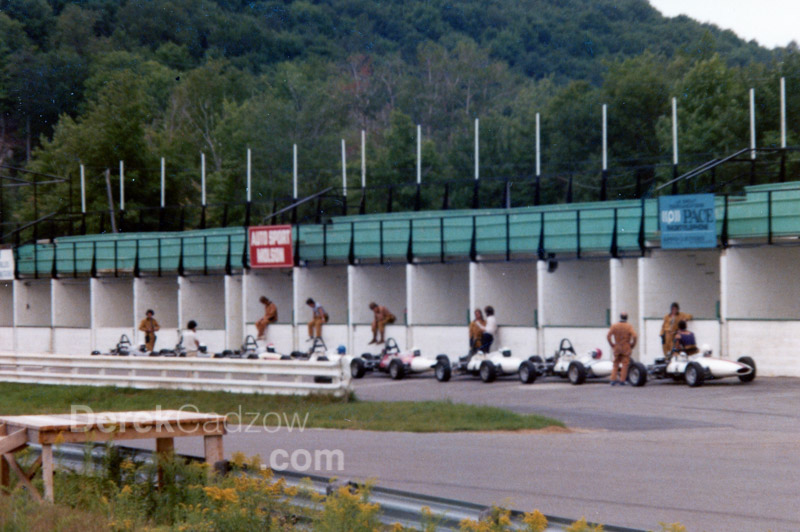
In the afternoon, we finally got our butts in the seats and drove up and down the straightaway practicing gear changes. The cars’ gearboxes had no synchromesh (typical of racing cars at that time) and it was a bit of a skill to match the engine revs with the speed of the wheels so you could successfully change gears. We got the hang of it quickly as we’d been practicing double-clutching and heel-and-toeing for years.
For the next two days, it was 10-lap lapping sessions at ever-increasing speeds. They used rev limits to govern our speed — that is, only allowing us to do so many revolutions per minute (RPMs) on the engines. They started each of us at intervals so there was no possibility of running together on the track.
Before we got started, we all piled in a gold-colored Pontiac station wagon and Jacques drove us around the course. He demonstrated how to drive through each corner: the braking zone, the turn-in point, the apex, where to unwind the wheel, and where to accelerate.
I had brought my helmet and driving gloves with me but I was surprised to learn that the coveralls they provided were simply cotton mechanic overalls — I had expected fire-resistant driving suits at least!
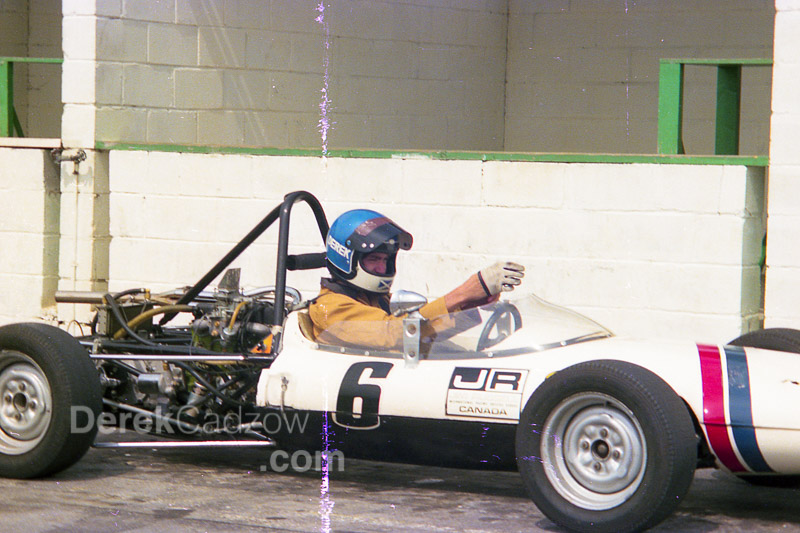
At the end of each ten-lap session, we’d report to the pits and Jacques would give us his assessment on how we did and offer advice for improvement.
Two things I remember:
He said I was using TOO MUCH of the track and not leaving enough of a safety margin on the exit of the corners. This one struck me as a bit odd given that successful drivers usually use all of the track and more. But, he was the champion and I wasn’t…
He also told me not to lean my head into the corner. Instead, I should keep it straight and turn, not lean, my head into the corner to see where I was going. If you lean it, he said, you’re confusing the balance mechanism in your inner ear. I already knew that car control and speed was all about balance — so that made sense. Then he threatened to duct-tape my helmet to the roll bar if I didn’t stop doing it. 🙂
There was lots of good advice whenever we came in.
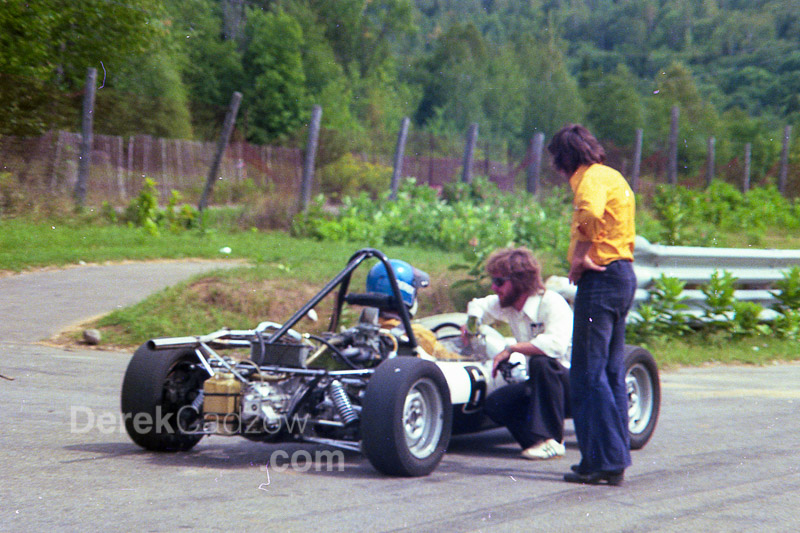
With the rev-counter on the dashboard, sticking to the RPM limit was pretty easy. Well, except for the time my extra-large feet somehow got stuck in the accellerator mechanism…
Just after the bridge turn I pushed in the clutch to change gears, but even though I released gas pedal, the revs continued to go up… and up… agh!
I quickly pulled my whole foot away from the pedal and the revs went back down. But by that time, the tell-tale needle (yes, that’s what its really called) showed that my maximum revs had reached 2900, about 500 over the limit they’d given us.
That’s not a big deal when you’re practicing at low revs in a school, but in a race when you’re using maximum revs, an error like that could cost you an engine … and the race!

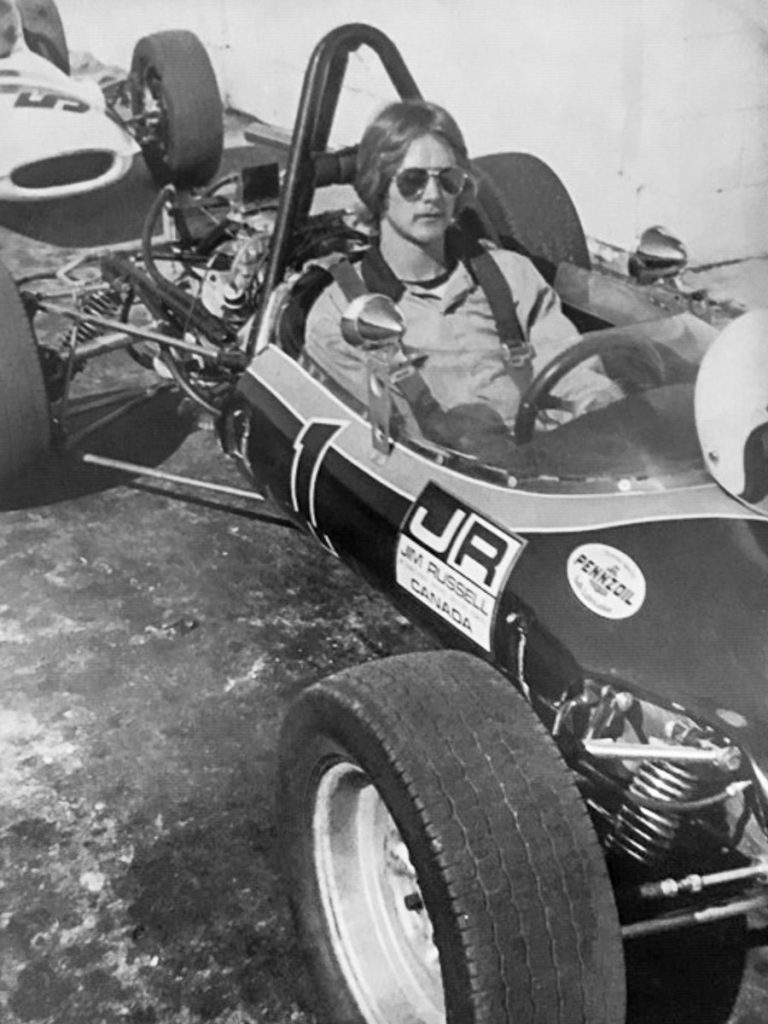
I pulled into the pits and waited for Jacques to come over. I explained what had happened and he listened with patience and ensured that I understood that in a race situation that wouldn’t be a good thing. Then he sent me back out to complete my ten laps.
Because of my delay, everyone else finished their ten laps before me and I was on the track alone for 2 or 3 laps. All the marshalls started to leave for lunch.
On my next-to-last lap, I hit the apex too early at one particular corner. As I exited, the outside rear wheel dropped onto the dirt at the edge of the track and the car skidded slightly sideways.
I corrected for the skid like I would have in my road car. In my MG, I’d steer into the skid to correct it, let go the wheel and let it spin back to center by itself, and grab it when it was at center to complete the correction. This worked fine in my MG and it was faster and easier than keeping your hands on the wheel through whole exercise.
But, in a Formula Ford, it didn’t work quite that way.
As the back end of the car stepped out, I steered into the skid and then let go the wheel as I normally would. When I tried to get my hands back onto the wheel, my knuckles hit the edge of the racing car’s windshield (ouch!) and I missed it at the critical moment!
Now the car’s back end swung the other way, and then back the original way. I could see this green bush on the inside of the track coming at me pretty quickly. Fortunately, by keeping my hands on the wheel this time and quickly correcting for each swing, I got the car back under control — but not before I had given my heart a good workout.
Back in the pits, eagle-eyed Jacques reviewed my lapping session and asked about this one lap with a slower lap time than all the others. I didn’t share the story; I was too embarrassed about my little incident. I claimed ignorance and we broke for lunch. I shared the story with David and we had a good laugh about it.
But Jacques was no dummy. After lunch we did the station wagon tour again with Jacques reviewing cornering technique. As we reached “my” corner, Jacques just interjected without taking a breath: “… and someone’s dropped a wheel there..”. David and I looked at each other and snickered — he knew.


Prior to lunch, they implored us to eat light and not to have any sugary desserts or candy bars. Your stomach, they said, takes too much of a pounding when lapping and they advised against it.
But, of course, there’s always one.
A classmate whose name is lost in the mists of time, had a few chocolate bars and jumped back into the car for the afternoon sessions.
I noticed partway into the session that his car had pulled into the pits. By the next lap, they had removed the bodywork and were hosing the car down.
Yep, you guessed it — our lunchtime rebel had revisited his candy bars in the car while lapping. Fortunately, he didn’t have a full-face helmet on, just the school’s helmet which had the full face shield clipped to it. The confined space of a full-face helmet would have made the situation much more gross…
On the third day my Mom turned up and shot some color photographs of us around the track in our cars (all the color pics on this page are her’s). She even managed to wangle her way up on top of the starter’s rostrum so she could photograph us whizzing by underneath!
Of course, they also had a professional photographer there to do stock black and white pictures we could buy (and of course we did — after all, it was US, in racing cars!), but I was grateful to her for the color ones she took.
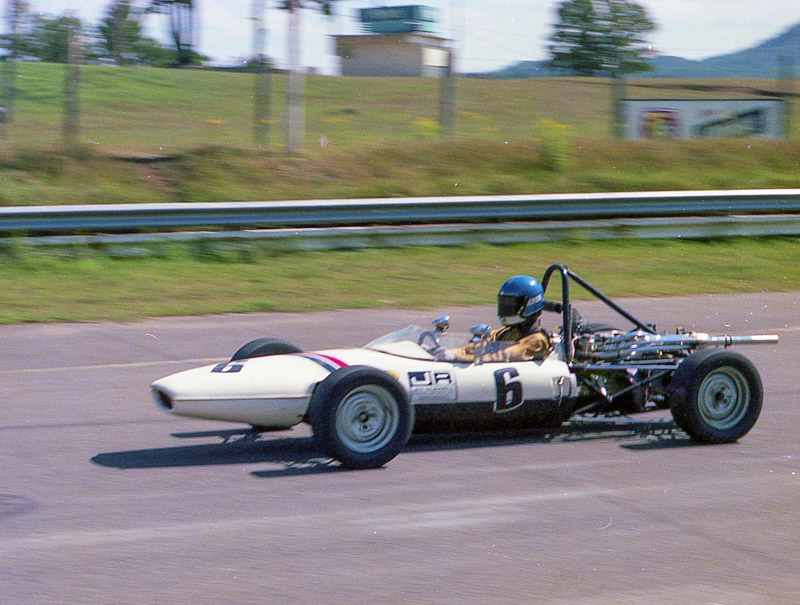
For once, David and I were turning similar lap times. But there was one fellow who was quite quick. I don’t know his name, but he was from Quebec and his english wasn’t too good. Our french wasn’t much better so it was difficult to converse. We mostly spoke haltingly about his mid-engined Fiat X1/9 road car, which quite intrigued us.
For the last lapping session, they let us zoom around the full Grand Prix track for 10 laps including down the long straightaway and over the hill at speed. That unnamed Fiat X1/9 driver was quite fast again, but I learned later that he used more revs than he was supposed to because it was the final session.
I wish I had thought of that — I was too much of a good boy!
After driving the small racing cars for three days, getting back into my MGB was like getting into a Volkswagen. You felt like you were sitting very high and bolt upright!
On our way home, the school experience came in very handy. While travelling round a right hand high-speed bend on a two-lane road, my left-rear tire decided to deflate suddenly — with a car coming the other way!
My heart jumped a bit, but I brought it to a stop and we changed the tire easily thanks to the single knock-off nut in the center of the wire wheel. That was the first of a few flat tires over the next few months as the wire wheels were starting to corrode and the spokes broke and punctured the inner tube. It was an early warning that winter weather and salt was just not that great for the health of the MG.
As far as my racing ambitions go, this should have been the moment in which I set off on my racing journey. Having finished the school, I was now eligible to compete in regional races and, if approved by the race officials after two trial runs, I could have earned a proper racing license. I’d already been considered for an endurance car race at Shannonville if I’d had the license.
But my goals were already fixed to karting because I could afford it and it was the easiest way to go racing. Nowadays, that would be a recognized path to car racing; back in those days it was still regarded as something separate from proper motorsport.
So the $64 million question is: if there had been no karting available to me, would I have pursued my racing license, competed on full-size tracks, and raced cars instead of karts?
It’s interesting to think about but, of course, we’ll never know the answer. We can only speculate.
It’s possible that it could have happened that way but it’s also possible I would have bankrupted myself quite early in life. But, you know, the passions of the young don’t consider such possibilities…
In the end, of course, I went karting and found it very fast, very competitive, and both exciting and rewarding. I still remember six years of kart racing as some of the most fun in my life and the friends I made there as some of my best.
Read the next installment in the series coming soon: Kart racing returns to the capital.


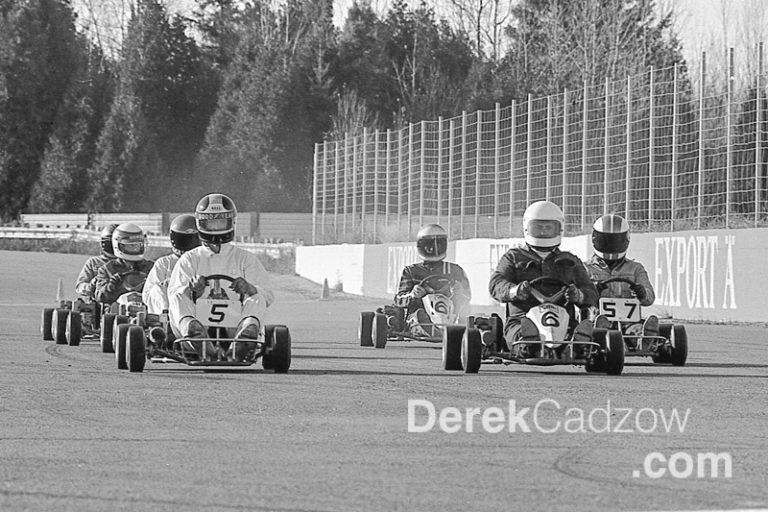

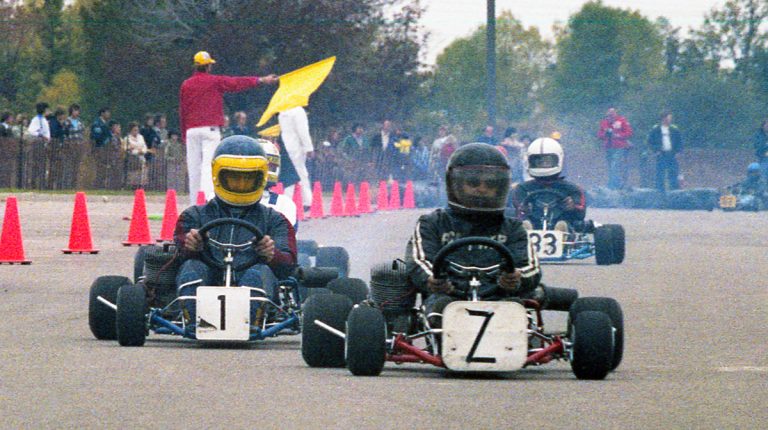
Dang Derek, you’re a good writer & storyteller. Good read!!
Thanks Sean. There are a lot of good stories from that time in our lives to tell. Now that I’m finished with all the things we got up to before we got into karting, I’ll be starting to write about the karting years and I’m sure you’ll figure prominently in some of those stories.